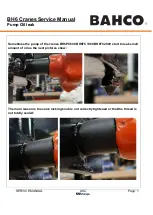
53
CHEMICAL APPLICATION AND OPERATING VARIABLES FOR
THE MACDON FIELD SPRAYER
1. Preparing for Spray Application
Satisfactory function of the spray system in all
situations requires making proper adjustments to
suit various crops, conditions and the chemicals
being applied.
Correct operation reduces crop loss and increases
chemical effectiveness. Proper adjustment and
timely maintenance will increase the length of
service of the sprayer attachment as well.
The variables listed here and detailed on the
following pages will affect the performance of the
equipment. You will quickly become adept at
adjusting the machine to give you the desired
results.
Consult with your state or local agricultural
department and the chemical manufacturer for
precautions to be taken when handling and
applying specific chemicals.
Before you can begin spraying you must:
1. Choose the chemical to be applied.
2. Determine the application rate specified by the
chemical manufacturer including:
a.
The amount of chemical to be applied per
acre or hectare.
b. The recommended application rate
(gallons per acre or liters per hectare) of
chemical when it is mixed with solution.
3. Select the travel speed depending on the field
conditions.
4. Select a nozzle tip based on the application
rate that is recommended. Several factors to
consider when selecting the nozzle include:
a. the output pressure,
b. the spray pattern angle,
c. the boom height, and
d. the nozzle spacing.
5. Calibrate the variable rate controller to
accommodate the chemical, nozzle and
ground speed choices.
Consult the MT-3405 Operator’s Manual supplied
by Micro-Trak for instructions to calibrate the rate
controller. The MacDon Field Sprayer is equipped
with an ultrasonic speed sensor, flow sensor and
flow control to provide “on-the-go” application rate
adjustment.
















































